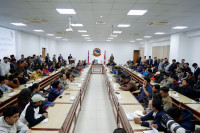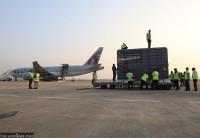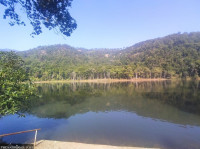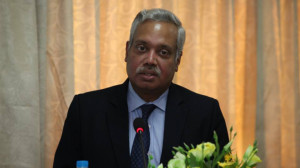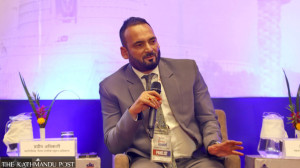National
Investment models for Budhigandaki, Upper Arun hydel projects approved
Energy Minister Ghising says it is now essential to finalise the investment modality and move towards construction.
Post Report
Prioritising domestic investment, the proposal of the investment modality for the 1,200-megawatt Budhigandaki reservoir-based hydropower project and the 1,063-megawatt Upper Arun semi-reservior hydropower project was finalised on Sunday.
Minister for Energy, Water Resources and Irrigation Kulman Ghising, who is also the minister for Physical Infrastructure, Transport and Urban Development, was briefed on the proposed investment modality prepared together with the financial analysis of both projects on Sunday. After the briefing, Ghising instructed that the proposal be submitted for necessary approvals.
Claiming that both projects have remained only in discussion for a long time, Ghising during the meeting said that it is now essential to finalise the investment modality and move towards construction.
“Investment modality of both the projects are now being prepared to be presented before the Cabinet for the final approval,” said a source close to Minister Ghising. “At a programme attended by the minister and officials of the Nepal Electricity Authority, both projects submitted their proposals. Once the Cabinet passes it after it gets tabled, it will move into the implementation phase.”
As the interim government seeks to advance two major hydropower projects, questions remain over whether the government formed after the election will endorse these moves. There are also concerns about the implications of a government formed with the primary objective of holding elections on March 5—following the dissolution of Parliament after the Gen Z movement—making decisions of long-term significance.
However, Sarita Dawadi, secretary at the Ministry of Energy, Water Resources and Irrigation, says that previous governments had also been trying to move these projects forward, and that work on advancing the Budhigandaki Hydropower Project had already begun with the establishment of a dedicated company. Therefore, she maintains, the incoming government will also assume ownership of the decisions taken by the current one.
“The submitted proposal will now go to the Ministry of Finance for financial approval, and once endorsed there, it will be forwarded to the Cabinet,” Secretary Dawadi told the Post.
The proposal includes raising investment by issuing shares of the NEA, issuing energy bonds, taking loans from banks and financial institutions, obtaining concessional loans from the government, allocating a portion of the infrastructure tax collected on petroleum imports, and issuing shares targeted at Nepalis working abroad, non-resident Nepalis, and the general public.
The government had begun collecting an infrastructure tax of Rs5 per litre on petrol and diesel in the fiscal year 2015–16 to fund the 1,200-megawatt Budhigandaki Hydropower Project, which is listed as a national pride project. The tax was later revised and increased to Rs10 per litre.
Although the government had previously signed an agreement allowing the Chinese company Gezhouba to build the Budhigandaki Hydropower Project, it later cancelled the deal, declared the project a national pride project and announced that it would be built with domestic investment. However, despite this announcement and the long-running collection of taxes on petrol and diesel, the project had yet to gain momentum.
The proposal clearly maintains that the investment modality of the Budhigandaki and Upper Arun will be different, according to the official from the Energy Ministry. While Budhigandaki will have the investment from the government apart from the government agencies, Upper Arun only will have the facilitation from the government.
“As Upper Arun is an attractive project in itself, we may require some technical support from the government, but we do not need financial assistance for its construction; it can be built with the support of government institutions alone,” said Ram Chandra Poudel, the project chief of Upper Arun Hydroproject.
The base cost of the Budhigandaki storage hydropower project—located in Dhading and Gorkha—is USD 2.77 billion (approximately Rs374 billion).
The construction period has been set at eight years. Including interest during construction, amounting to Rs32 billion, the total project cost reaches Rs406 billion.
Based on this total cost including interest, the debt-equity ratio has been set at 70:30. The promoter company, Budhigandaki Company Limited, will have 80 percent government ownership and the Nepal Electricity Authority will have 20 percent ownership.
Once the project is completed or reaches its final stages, shares may be issued to the general public based on financial indicators, viability and suitability, with the aim of reducing debt burden or restructuring the government’s shareholding.
The government will contribute Rs97.47 billion as equity and Rs150 billion as concessional loans, making a total investment of Rs248 billion. The Rs45 billion already spent by the government on the project is proposed to be converted into equity.
It is also proposed that the government invest the amount collected through customs duties and value-added tax on project-related imports. Furthermore, 50 percent of the infrastructure tax levied on petroleum imports at customs points is proposed to be allocated for the project.
After deducting the investment already made, the government must secure a source for Rs228 billion for the project. The NEA will invest Rs24.37 billion as equity. To reduce financial costs and make the project viable, a proposal has been made to issue Rs30 billion in energy bonds, counted towards the mandatory liquidity ratio, which banks, financial institutions, insurance and reinsurance companies and public funds can purchase.
“Compensation totalling Rs42.65 billion has been distributed to landowners for land, structures, trees and crops. A total of 8,117 households in Gorkha and Dhading will be physically and economically affected, of which 3,560 households will be fully displaced,” the energy ministry has said.
The reservoir created by the dam will cover 63 square kilometres upstream. The 63-sq-km reservoir is expected to create new opportunities for employment, business, tourism hubs, fish farming and benefits to downstream areas. The maximum water level of the reservoir will be 540 metres.
The 1,063-megawatt Upper Arun semi-reservior hydropower project, led by the NEA and located in Bhotkhola Rural Municipality of Sankhuwasabha, has an estimated cost of USD 1.75 billion (around Rs214 billion), including interest during construction and inflation.
Upper Arun will also follow a 70:30 debt-equity investment structure. Of the 30 percent equity, 51 percent will be allotted as promoter shares and 49 percent as ordinary shares. As much as Rs36.67 billion will be collected from promoter shareholders and Rs35.23 billion from ordinary shareholders.
Promoter shareholders will include provincial and local governments, the NEA, Nepal Telecom, Employees’ Provident Fund, Citizen Investment Trust, Social Security Fund, HIDCL, insurance companies and NEA’s subsidiary companies.
Ordinary shareholders will include Nepalis working abroad, non-resident Nepalis, employees of promoter institutions, project-affected locals and the general public. Upper Arun Hydro-Electric Limited has already been established as the project developer.
A memorandum of understanding has already been signed among the NEA, the promoter company and banks and financial institutions for co-financing worth around Rs53 billion, said Poudel, project chief of Upper Arun Hydroproject.
The project will produce 4.53 billion units of electricity annually. Pre-construction works are ongoing. Construction of a 21-kilometre access road from the proposed powerhouse site at Chongrang in ward 4 of Bhotkhola Rural Municipality to the dam site near Chepuwa village in ward 2 is underway.
While the investment modality presented by the Budhigandaki Hydroproject to the Energy Minister Ghising was passed by the hydroproject’s board, Upper Arun Board is still to pass the modality. “There could be a bare minimum amendment in the original proposal,” Poudel said. “But the major content of the modality will be the same.”




 6.12°C Kathmandu
6.12°C Kathmandu